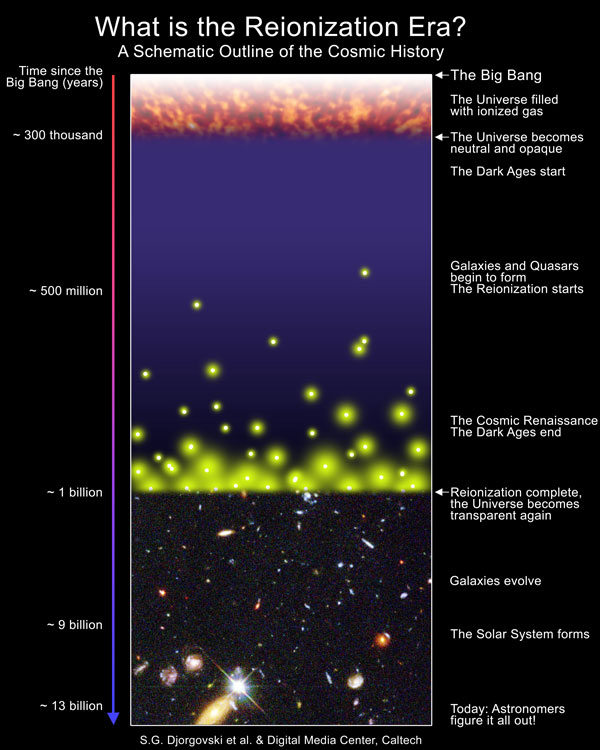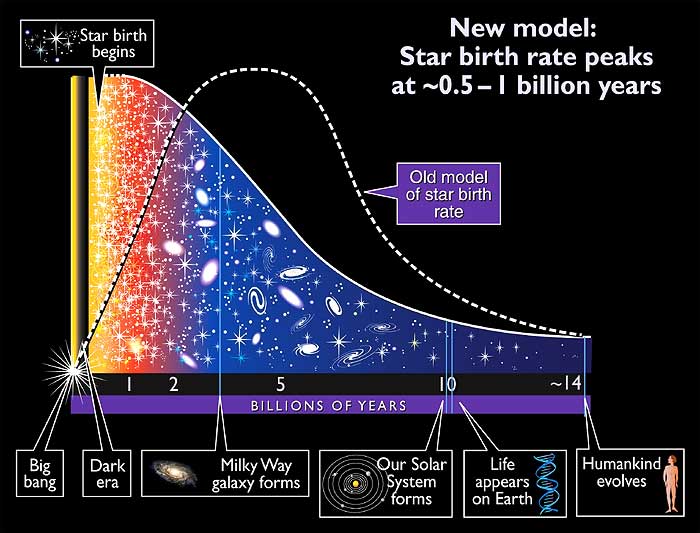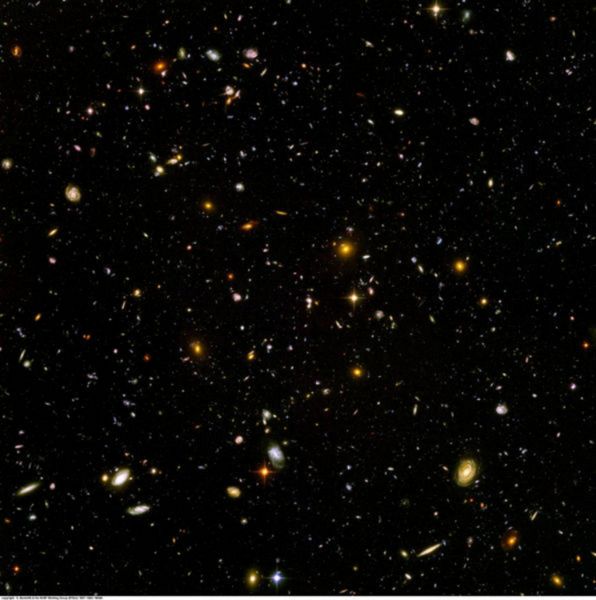
Galaxies and Stars
| Palaeos: |  |
The Stelliferous Era |
| COSMOS | Structure formation Galaxies and Stars |
| Page Back: Stelliferous Era | Unit Up: Cosmos home | Unit Home | Page Next: The Elements |
| Unit Back: The Primordial Era | Page/Sequence Back: The Early Universe | Glossary | Unit Next: The Chaotian Eon |

Editor's note: I'm just copying this from Wikipedia, with some additional material from various sources. Essentially, this is just a basic place holder page and collection of notes and diagrams. In the future more could be added here, if someone wants to contribute MAK110725
Structure formation in the big bang model proceeds hierarchically, with smaller structures forming before larger ones. The first structures to form are quasars, which are thought to be bright, early active galaxies, and population III stars. Before this epoch, the evolution of the universe could be understood through linear cosmological perturbation theory: that is, all structures could be understood as small deviations from a perfect homogeneous universe. This is computationally relatively easy to study. At this point non-linear structures begin to form, and the computational problem becomes much more difficult, involving, for example, N-body simulations with billions of particles. - Wikipedia
Hydrogen Reionization: 150 million to 1 billion years: The first stars and quasars form from gravitational collapse. The intense radiation they emit reionizes the surrounding universe. Energy from these early massive stars ionized cold interstellar hydrogen from the big bang. This epoch is called reionization because the hydrogen nuclei were originally in an ionized state shortly after the big bang. From this point on, most of the universe is composed of plasma. - Hubblesite, Wikipedia

First Light, after a few hundred million years of darkness (the opaque universe or "dark ages"). This first light is believed to have been captured in data from NASA's Spitzer Space Telescope, which detects infrared. The light detected by Spitzer would have originated as visible and ultraviolet light, then stretched, or redshifted, to lower-energy infrared wavelengths during its long voyage to reach us across expanding space. The cosmic microwave background radiation detected by the Cosmic Background Explorer and the Wilkinson Anisotropy Microwave Probe traveled farther to reach us, and so stretched to even lower-energy microwave wavelengths. From Brief History of the Universe
Astronomers do not know if the very first objects were either stars or quasars.
Formation of stars: The first stars, most likely Population III stars (our sun is a Population I star), form and through nuclear fusion begin turning the light elements that were formed during the nucleosynthesis stage (hydrogen, helium and lithium) into heavier elements. These stars were thought to have been much larger and brighter than any in our nearby universe, with masses about 1,000 times that of our sun. As of yet there have been no observed Population III stars, and understanding of them is currently based on computational models of their formation and evolution. These stars grouped together in mini-galaxies. The first quasars ultimately became the centers of powerful galaxies that are more common in the distant universe. (From Brief History of the Universe, Wikipedia)

Formation of galaxies: Population II stars are formed early on in this process, with Population I stars (the majority of current stars, including the Sun) formed later.
13.1 bya (600 million years after the Big Bang) UDFy-38135539 (also known as "HUDF.YD3") is the Hubble Ultra Deep Field (UDF) identifier for a galaxy which has been calculated (as of October 2010) to have a light travel time of 13.1 billion years with a present co-moving distance (due to expansion of the universe) of around 30 billion light-years. It is the first observed galaxy to have existed during the reionization epoch, gives us a window into the early universe. There was a report in January 2011 of yet another more than 13 billion years old that existed a mere 480 million years after the Big Bang. - Wikipedia

 Hubble Deep and Ultra Deep Field, in relation to the Big Bang. By looking into furthest space we are actually looking back in time. Image from Space-Time and Expansion of the Universe |
Hubble Ultra Deep Field. Each of the blotches of light is a galaxy, each galaxy containing tens to hundreds of millions of stars - MAK The Hubble Ultra-Deep Field (HUDF) is an image of a small region of space in the constellation Fornax, composited from Hubble Space Telescope data accumulated over a period from September 24, 2003, through to January 16, 2004. It is the deepest image of the universe ever taken, and hence shows the earliest galaxies, looking back approximately 13 billion years, between 400 and 800 million years after the Big Bang, when the Universe was only 5% its current age, and will be used to search for galaxies that existed at that time. It shows a number of small galaxies merging to form larger ones, - Wikipedia

12 1/2 bya (1000 million years after the Big Bang) The Hubble Deep Field (HDF) is an image of a small region in the constellation Ursa Major, constructed from a series of observations by the Hubble Space Telescope. It covers an area 2.5 arcminutes across, two parts in a million of the whole sky. The image was assembled from 342 separate exposures taken with the Space Telescope's Wide Field and Planetary Camera 2 over ten consecutive days between December 18 and December 28, 1995. The field is so small that only a few foreground stars in the Milky Way lie within it; thus, almost all of the 3,000 objects in the image are galaxies, some of which are among the youngest and most distant known. By revealing such large numbers of very young galaxies, the HDF has become a landmark image in the study of the early universe, with the associated scientific paper having received over 800 citations by the end of 2008. - Text and image from Wikipedia
12 bya protogalactic clouds of hydrogen form; the Universe differentiates into vast clumps of gaseous matter.
By about a few billion years after the Big Bang, the mini-galaxies of the Hubble Deep and Ultra Deep field had merged to form mature galaxies, including spiral galaxies like our own Milky Way. (From Brief History of the Universe)11 bya to present galaxies interact: some collide and are engulfed; others pass through one another, usually with tremendous gravitational impact to both. - Epic of Evolution Timeline - Connie Barlow and Michael Dowd
Helium Reionization - 11.7 to 11.3 billion years ago, when the universe stripped electrons off from primeval helium atoms — a process called ionization. This process heated intergalactic gas and inhibited it from gravitationally collapsing to form new generations of stars in some small galaxies. The lowest-mass galaxies were not even able to hold onto their gas, and it escaped back into intergalactic space. Hubblesite
10 bya first population I stars, which contain heavier elements and hence are more likely to be accompanied by planets
ca 8 bya Based on nucleocosmochronology, the disk of the Milky Way is estimated to have been formed 8.3 ± 1.8 billion years ago. - Wikipedia
| Page/Sequence Back: The Early Universe | Page Back: Unit Home | Page Top | Unit Home | Page Next: Elements | Sequence Next: The Chaotian Eon |
content by Wikipedia, Epic of Evolution. Edited RFVS111026